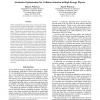Free Online Productivity Tools
i2Speak
i2Symbol
i2OCR
iTex2Img
iWeb2Print
iWeb2Shot
i2Type
iPdf2Split
iPdf2Merge
i2Bopomofo
i2Arabic
i2Style
i2Image
i2PDF
iLatex2Rtf
Sci2ools
AAAI
2007
2007
Stochastic Optimization for Collision Selection in High Energy Physics
Artificial intelligence has begun to play a critical role in basic science research. In high energy physics, AI methods can aid precision measurements that elucidate the underlying structure of matter, such as measurements of the mass of the top quark. Top quarks can be produced only in collisions at high energy particle accelerators. Most collisions, however, do not produce top quarks and making precise measurements requires culling these collisions into a sample that is rich in collisions producing top quarks (signal) and spare in collisions producing other particles (background). Collision selection is typically performed with heuristics or supervised learning methods. However, such approaches are suboptimal because they assume that the selector with the highest classification accuracy will yield a mass measurement with the smallest statistical uncertainty. In practice, however, the mass measurement is more sensitive to some backgrounds than others. This paper presents a new appr...
| Added | 02 Oct 2010 |
| Updated | 02 Oct 2010 |
| Type | Conference |
| Year | 2007 |
| Where | AAAI |
| Authors | Shimon Whiteson, Daniel Whiteson |
Comments (0)

